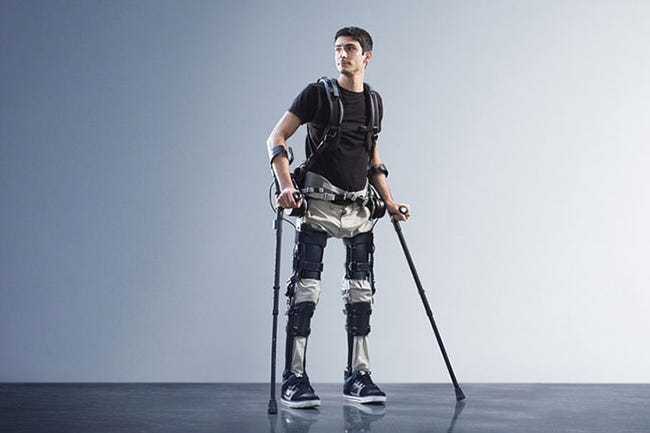A Next-Gen Lightweight Exoskeleton to Help Paralyzed Walk
February 5, 2016
The new prototype weighs just 27 pounds and can be custom-fit to virtually any body type -- returning movement to the hips and knees with small motors.
Kristopher Sturgis

In 2010, medical exoskeleton technology received considerable accolades. Wired magazine declared Berkeley Bionics' technology (the company was later renamed as Ekso Bionics) to be one of the most significant technologies of the year and Time magazine named the technology as one of the top 50 technologies of the year.
Fast forward to 2016 and giving wheelchair-bound patients an option to stand and walk still seems like a powerful accomplishment. And while there are several companies active in promoting this technology, it still isn't widely used.
Now, Homayoon Kazerooni, a robotic exoskeleton technology pioneer and one of the innovators behind Ekso Bionics technology, has developed a new suit known as the Phoenix. (He cofounded Berkeley Bionics in 2005.)
With an expected cost of $40,000, and weighing in at just 27 pounds, the Phoenix would become the lightest and cheapest exoskeleton suit on the medical market. The suit also comes with an adjustable design so it can custom fit to any patient's height and body structure. The whole device is powered by a battery pack worn as a backpack that can power the suit for up to eight hours, and even links with a smartphone app that can track the patient's walking data.
"We can't really fix their disease," Kazerooni told university news. "We can't fix their injury, but what it would do is postpone the secondary injuries due to sitting. It gives a better quality of life."
The genesis of the suit actually stems back to similar technologies created at the UC Robotics and Human Engineering lab that Kazerooni leads. He says his ultimate goal is to create a version of the suit for children who suffer from neurological disorders. The Phoenix already serves a purpose beyond helping the paralyzed walk; the device was also designed as a therapeutic solution for patients who have suffered a stroke or have suffered the loss of other motor functions.
These days, exoskeleton technologies continue to astound as engineers find new uses for the technology in new and exciting ways. In 2014, a nonprofit worked in collaboration with several different universities to display the world's first mind-controlled exoskeleton device at the FIFA World Cup soccer tournament in Brazil.
Just a month later ReWalk, a bionic walking assistance technology, became the first wearable motorized device cleared by the FDA. It became the first exoskeleton technology to receive approval as a device to aid paraplegics, and may have paved the way for technologies like the Phoenix.
Today, the Phoenix aims to surpass all other exoskeleton prototypes as it looks to become more accessible and easier to use than any other device on the market. Although $40,000 isn't cheap, it would still be roughly half the cost of any other exoskeleton technology on the market that aims to restore mobility. For now, all indications are that exoskeleton technologies will only become more ubiquitous as the technology progresses, and the Phoenix suit could be leading the way.
Learn more about cutting-edge medical devices at MD&M West, February 9-11 at the Anaheim Convention Center in Anaheim, CA. |
Like what you're reading? Subscribe to our daily e-newsletter.
About the Author(s)
You May Also Like

.png?width=300&auto=webp&quality=80&disable=upscale)
